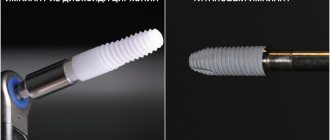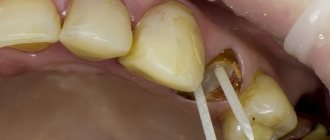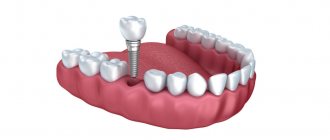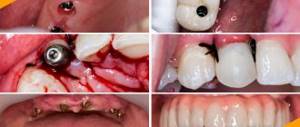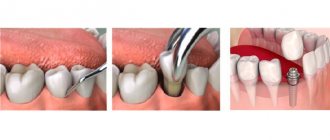Implantation without an incision is a marketing name that reflects the meaning of the procedure. This type of implant installation is also called transgingival, endoscopic, non-surgical or bloodless. This treatment has been known in Europe for 15 years , in Russia - relatively recently, but the popularity of the method is growing.
The process of installing an implant without an incision
What is implantation without a gum incision?
First, let's figure out what classical implantation is. This protocol involves the introduction of a titanium root (implant) into the bone tissue at the site of the missing tooth. The surgeon acts like this:
- Cuts the mucous membrane.
- Folds back the gingival flap.
- If necessary, it builds up bone tissue.
- Places an implant.
- Places stitches.
- After the implant has healed, a permanent crown is installed.
Tooth restoration takes 5-6 months , since it requires healing of the gums, fusion of the implant with the bone tissue, and installation of a crown after osseointegration.
Unlike the classical method, implantation without incisions allows you to skip several stages and avoid large incisions in the gums:
- To install the implant, one hole with a diameter of several millimeters is made.
- The implant is implanted.
- A gum former or temporary lightweight crown is immediately installed.
- After the implant has healed, a permanent crown is fixed in 2-3 months .
This treatment is recommended:
- people with diseases of the endocrine and cardiovascular systems;
- for those who are against surgery.
The bloodless method accelerates the restoration of the dentition.
Contraindications
Non-surgical implantation is especially suitable for people who are terrified of surgical intervention. But its use is possible only after examining the patient, since this type of operation is performed with absolutely healthy tissue and excellent bone quality in the area where the titanium root is implanted. Non-surgical implantation is prohibited in the following cases:
- advanced periodontitis;
- acute inflammation in the implantation area;
- periodontal cyst;
- narrow crest of the alveolar process;
- lack of bone tissue volume;
- swelling of the mucous membrane.
Features of the method
The method is not suitable for patients with bone deficiency for reliable fixation of an artificial rod. It is impossible to increase bone mass without making an incision in the gums, so non-surgical treatment is available to only 5% of people.
The volume of the mucous membrane is also taken into account. If the gum thickness is less than 2 mm, an implant cannot be installed using a non-surgical method. Under the influence of the titanium root, the mucous membrane will stretch and become even thinner. The thinner the gums, the greater the risk of inflammatory processes and implant rejection. The fact is that opportunistic bacteria, which are normally found in the oral cavity, can seep through the thin soft tissue and destroy the bone underneath. For thinned gums, we recommend enlarging the incision and performing implantation using a patchwork method.
In our Center, implantation without incisions is not covered by a lifetime guarantee.
Related articles:
- Other implantation methods
- Our guarantees
- Implant lifespan
Preparation for dental implantation without incisions
The first stage for any implantation protocol is the same. This is a thorough diagnosis and preparation of the oral cavity. Diagnostic procedures include:
- X-ray
- Orthopantomographic scan
- In some cases - CT or MRI of the jaw area.
Laboratory tests include a general blood test and blood sugar test.
Preparation of the oral cavity includes sanitation - treatment of all carious teeth, elimination of gum problems, removal of rotting roots or hopeless teeth affected by the inflammatory process. All this is done in order to eliminate the possibility of pathogenic flora in the mouth affecting the area around the implant. This is a prerequisite for the prevention of re-implantitis and implant rejection. Before implantation, a hardware cleaning of the oral cavity is carried out in dentistry - stones are removed, and the interdental spaces are thoroughly cleaned of plaque.
Stages of bloodless implantation
With the seamless method, the implant is inserted through a puncture of the gum. Before the puncture, local anesthesia is given or the patient is put into medicated sleep.
- Using a circular mucotome, a circular incision is made for the titanium root. Preparing the hole begins by marking it with a ball bur. Sequential expansion is carried out using cutters of different diameters - from smaller to larger.
- Installation of an artificial root into the bone mass by screwing.
- Fixation of the healing abutment or abutment.
- It is possible to install a temporary lightweight crown immediately. After osseointegration, it is replaced with a permanent one.
Indications and contraindications
Implantation of an artificial root is used to restore lost teeth. Indications for use of the procedure:
- Missing one or more teeth;
- The need for rapid recovery;
- Absence of extreme dental units;
- Edentia.
Non-surgical dental implantation has a number of contraindications. It is strictly forbidden to carry out the procedure for people suffering from diseases of the gums, oral cavity, internal organs and circulatory system. It is not allowed to carry out the process of installing implants on patients who have been diagnosed with malignant processes in the body. In addition, contraindications apply to pregnant and breastfeeding women.
Features of the operation in our Center
- We begin transgingival implantation by creating a 3D model of the jaw. Our Center uses the “Nobel Guide” system. She creates an accurate virtual model based on mathematical calculations and produces a surgical template. With it, the doctor will determine where and at what distance to place the implants without cutting the gums. A tomograph and an X-ray machine do not provide such accuracy. The very name “implantation without incision” was invented by marketers to promote the “Nobel Guide” protocol.
- When the surgical template is ready, the doctor places it firmly against the gum and makes one or more holes for the implants. The procedure is performed under local anesthesia or sedation and is painless for the patient.
- After inserting the rod, the doctor places a temporary crown if the tooth is in the smile zone.
- After 2-3 months, the patient comes to the clinic for the second time and leaves with a permanent crown, indistinguishable from a natural tooth. In classical technology, the last visit takes place six months after the start of treatment.
Make an appointment with an implantologist
What is meant by the concept of “dental implantation without surgery”?
Dental implantation has been successfully used by implant surgeons around the world for more than half a century. However, scientists are constantly working to develop new techniques to speed up and improve implantation technology. Today, using a surgical template, the doctor can accurately determine the location of implants and perform the operation without incising the gums and folding the mucoperiosteal flap, as happens with the classical technique. Naturally, you will still have to make an incision, but its dimensions will correspond to the diameter of the implant, not exceeding a few millimeters. This technology is called “dental implantation without surgery,” endoscopic, or transgingival implantation.
Rehabilitation period
Rehabilitation with the sutureless method takes less time compared to classical implantation. The operation is minimally invasive, without stitches, and therefore the implants take root quickly.
The risk of complications is minimal, since surgical manipulations practically do not injure fibrous tissue. But this does not mean that in the postoperative period the patient should not follow a certain regimen:
- On the recommendation of a doctor, antibacterial therapy, anti-inflammatory and painkillers are prescribed.
- On the first day you should not eat solid food.
- On the second day, if there is no pain, swelling and temperature, the gentle regime and anti-inflammatory drugs are canceled.
"Implantation without surgery"
What is “implantation without surgery”?
This method of dental implantation has several names:
non-surgical dental implantation, seamless and bloodless
.
However, implant surgeons mean by this term a one-stage method of implantation and its variation, an operation using a surgical template. Implantation using this method is carried out if no more than a year has passed since tooth extraction. The dental clinic "Dentist" in Moscow
successfully uses surgical templates when installing implants using a one-stage protocol.
Why is this technique also called “implantation without surgery”?
1. When installing an implant, the doctor pierces rather than cuts the gum. The operation is bloodless and there is no need for stitches. And although the surgical intervention is minimal, you need to understand that it is still an operation.
2. After installing the implant, a temporary structure is installed in the smile area, which does not bear any chewing load. On the chewing teeth, depending on the situation, either a temporary structure or a gum former.
IMPORTANT:
Loading with permanent structures is possible only after complete osseointegration of the artificial root.
Advantages of “implantation without surgery”.
Of course, the one-step protocol has many positive aspects, it
It is easier to tolerate by patients, takes little time and does not require serious rehabilitation. This is the optimal way to restore one or more teeth, as well as a very good solution for removable dentures in the case of complete absence of teeth.
- The operation is comfortable and painless - in fact, a puncture is made, not an incision in the gum.
- Installing implants takes less time.
- Swelling of the gums is less pronounced.
- An aesthetic point, the ability to install a temporary structure.
- High implant survival rate of 90-95%.
- Less risk of rejection.
IMPORTANT:
The absence of repeated surgical intervention allows you to avoid a difficult rehabilitation period, accompanied by swelling and pain, and also reduce the treatment time by half. In addition, immediate loading of the implant with a crown allows you to preserve the natural shape of the gums and does not require correction
Conditions for a one-step protocol.
To carry out such an operation, ideal conditions are required in one surgical stage:
- Sufficient volume of soft and bone tissue in the implantation area.
- Good quality bone in the place of the missing tooth will provide a primary one. stabilization of the implant.
- Good oral hygiene.
- The patient should not smoke.
One-stage implantation using a surgical template.
One-stage dental implantation
using surgical templates
, this is a modern digital method that allows you to install implants as accurately as possible and reduce
patient's stay in the clinic.
If it is necessary to install several implants at the same time with partial or complete absence of teeth, a surgical template can be used.
The surgical template is similar in appearance to a custom-made dental tray, but has holes of equal diameter on its surface. This template design is manufactured using 3D technology in a technical laboratory. Creating a custom template requires a preliminary CT scan, impression taking, and casting of the model. A form is created, scanned and loaded into a computer program, where it is combined with the results of a computed tomography scan. And as a result, a surgical template is created that will allow the implantation site to be determined as accurately as possible, the degree of inclination of the implant, taking into account the density of the patient’s jaw bone. And the holes are metal bushings, which completely eliminate deviations of the drill from the given trajectory during operation, but also limit the drilling depth.
Advantages of using surgical guides.
The use of surgical templates for one-stage implantation is
benefits not only for the doctor, but also for the patient.
- The most accurate placement of several implants allows us to predict future orthopedic designs.
- Safe and predictable implantation in complex anatomical situations.
- Minimal trauma, surgery reduces the risk of complications and the postoperative period is painless.
- It is easier to predict the outcome of surgery and prosthetics.
- Implantation is performed more accurately and with better quality.
- Safe implantation in all situations.
IMPORTANT:
The rate of engraftment of the artificial root depends only on the quality of the implant. And the way it is staged does not matter.
Price.
Patients come to our clinic “Dentist” with various problems after losing teeth,
And at the same time, each patient has his own priorities. Based on this, the price for one-stage implantation
one tooth with installation may vary depending on the type of prosthetics.
Working directly with the manufacturer Strauman allows us to carry out promotions
.
And then the price for turnkey implantation
is reduced and does not affect the quality of the procedure.
Of course, you can find out the approximate cost of treatment by calling our clinic by phone, but you can get a detailed treatment plan only at a free consultation at the Dentist clinic. IMPORTANT:
At the consultation, you will be able to find out the exact cost of implanting one tooth after an X-ray examination. Diagnosis and planning are the key to the success of any surgical intervention.
What are the advantages of “express implantation” at the Dentist clinic?
At the Dentist clinic near Chistye Prudy metro station
, approach the procedure very responsibly
one-stage implantation.
Computed tomography will help plan each step and helps assess the condition of bone tissue. Surgical templates are currently a modern solution for performing operations without making a gum incision. According to
experts, the future of implantation lies in these small structures.
We don’t just install implants , but solve the problem of a lost tooth once and for all!
- We are always ready to offer a high level of service and reasonable prices.
- We carefully plan our pricing policy, as we value each patient and count on long-term relationships with them.
- To achieve a positive result, we install Straumann implants ,
since the presence of
the SLActive surface
minimizes the risk of rejection. - The presence of special containers for storing and transporting implants allows you to keep the product sterile and ensure optimal humidity conditions.
- The titanium “root” is installed in the hole that appears after removal and allows you to do without additional incisions.
- We guarantee complete implant healing in 99% of cases. The implants installed in our clinic last more than 10 years.
- We use only certified materials and equipment.
If you are faced with the problem of missing teeth, our specialists will always help you choose the most optimal solution so that you can still smile serenely.
Consultations with any specialists in our clinic are free! Our patients are always satisfied with the results of our work!
Benefits of non-surgical implant installation
- The time to restore the dentition is reduced: after a maximum of 3 months, the patient is fitted with a permanent crown.
- The operation is faster: installing the rod using the classical method takes up to 8 minutes, and using the bloodless method – up to 2 .
- Rehabilitation is made easier: patients do not experience bruises, swelling, pain, or fever, and can work the next day after the implants are installed. It is especially important when restoring several teeth.
- The risk of implant rejection and infection is reduced since it does not require separation of the gum from the bone.
- Takes 10-15 minutes . Unlike the classic 3-stage method, with a non-surgical method the doctor installs a gum former or temporary crown immediately, without waiting for healing. The rehabilitation period is reduced by 2-2.5 times .
What is the cost of dental implants without surgery?
The average price of dental implantation without surgery is initially slightly higher than the classic one. However, the final cost of treatment using the transgingival method is several times cheaper, since its use does not require such additional and rather expensive manipulations as, for example, patch surgeries.
There is a stereotype among patients and some doctors that a good implant must be expensive. However, this statement is not always true. The implant is selected based on the individual characteristics of the body - in particular, depending on the density and volume of the jaw bone. The designs of different implant systems differ from each other, and sometimes a budget implant is more suitable for a patient than a premium product. In addition, thanks to diagnostics, the clinic can tell the patient the final cost of treatment in advance, which is undoubtedly a big advantage.
Price
Speed of the procedure does not mean cheaper. The amount of consumables and the cost of doctors’ work does not decrease. On the contrary, the price of implantation without an incision is higher due to:
- manufacturing a surgical template;
- mandatory three-time computed tomography.
The cost of a case for treatment is from 60,000 rubles . The amount includes the necessary procedures, the patient will not have to pay extra. For comparison, in Moscow clinics the price of the procedure starts at 45,000 rubles, but usually this amount is not final.
How is endoscopic or transgingival dental implantation performed?
As you know, there are several types of implantation and surgical techniques. The endoscopic technique is perhaps the most comfortable for the patient, but difficult for the doctor. At the first stage, images of the jaws are taken, then a special program notes where and at what angle the implants will be located, after which the image and records are sent to the laboratory. Based on the data obtained, specialists spend some time making a surgical template, which marks exactly where the implant or implants should be installed. At the second stage, the specialist can only firmly fix the template in the patient’s mouth and carry out implantation, having previously made a small hole in the gum and bone.
Options for implantation without incision
Implantation without surgery can be conditionally called 2 more types:
- Laser - a laser beam is used instead of a scalpel. The bloodless incision of the gum is accurate, while at the same time disinfecting the area and minimizing the wound healing time is ensured.
- Instantaneous immediately after tooth extraction - there is no need to make incisions in the gums, since the implant is implanted into a fresh socket. But it is not always possible to carry out the extraction carefully, and the disfigured socket is not suitable for installing an implant.
Traditional and transgingival implantation
Traditional implant placement is very traumatic. Installation of the product and the adaptation period require a lot of time, so experts prefer the non-surgical method of implanting dental structures. Traditional pin installation consists of the following steps:
- The specialist eliminates existing dental problems (tartar, caries, periodontal disease). After this, an implant is selected and an impression of the jaw is made. An incision is made on the periosteum and mucous membrane to introduce a bed under the product.
- After the operation, you must adhere to all the specialist’s instructions. As a rule, the patient is prescribed antibacterial and anti-inflammatory drugs and rinsing the mouth with antiseptic drugs.
- Osseointegration of the product lasts six months, then the specialist installs the abutment and temporary crown. After this, the doctor recommends coming back in two weeks. If during this period the healing process is successful, then a permanent crown or prosthesis is placed.
When dental implants are installed without a gum incision, this significantly reduces the healing time - the product takes from one to two months. In addition, there is no trauma or damage to the jaw nerve.
Methods and features
Basal implantation
This method allows you to restore three or more lost teeth. A distinctive feature is the ability to carry out the procedure without bone tissue augmentation. After the implant is installed, the dental structure is installed on the third day. The technique allows you to restore the functionality of the dentition and make it aesthetically pleasing.
With basal implantation, structures are used that can be installed in the deep layers of bone tissue. This allows the implants to be securely secured.
The procedure can be performed along with tooth extraction. The implant is placed into the socket without incision of the soft tissue; the upper part will extend to the surface of the gum. After three days, a removable structure is installed, which will secure the implants and evenly distribute the load during the process of chewing food.
Method with instantaneous load
The procedure allows you to restore one or more teeth in a scattered arrangement. After installing the implants, the prostheses are immediately fixed. This requires a sufficient amount of bone tissue.
To further secure the implants, temporary fixing structures are used, without affecting the adjacent teeth. The chewing load is restored gradually over a month after medical intervention.
Mini implantation
Using this technique, you can restore teeth using 4 implants on which conditionally removable dentures are fixed. This approach does not require a large amount of bone tissue.
Implants are installed through a special puncture in the gum; the procedure is less traumatic. After the intervention, the patient does not feel any discomfort. The upper part of the implants does not sink into the gum tissue, so the removable denture is fixed immediately.
Classic one-step procedure
With the help of such implantation, any number of teeth can be restored. The implant is fixed after the tooth is removed, after which it begins to take root in the tissues. After 2-4 months, the specialist installs the abutment and prosthetic structure. Sometimes it is possible to install a prosthesis while fixing the implant, in which case the procedure takes even less time. The technique is convenient for the patient and provides quick rehabilitation.
A few words about prices
The cost of dental implantation, including “non-surgical” ones, is influenced by many factors: from the level of the clinic, the type of implants used, and ending with the number of diplomas of the implantologist who will work with you. However, if the installation of implants is carried out in one stage (at the same time as tooth extraction), this usually slightly reduces the price of the procedure compared to classical two-stage implantation.
However, sometimes this rule may not work. For example, the use of expensive surgical guides or 3D modeling may be required. Surgical templates are made from impressions of the jaws and allow you to accurately plan the places for installing implants, the depth of their immersion, etc. 3D modeling technology allows you to virtually plan the upcoming operation, taking into account its smallest details and significantly reducing the likelihood of medical errors.
All these nuances contribute to the final price of dental implantation, sometimes significantly.
In order not to overpay for unnecessary manipulations, you should always first carefully and comprehensively study the clinic where implantation is to be performed, and trust a professional for whom hundreds of grateful patients can vouch.
It is especially important to listen to your doctor's advice regarding further tactics. If the implantologist does not recommend immediate or transgingival implantation, but offers the classic delayed technique, then it makes sense to listen to the advice rather than look for another clinic and another doctor who, in pursuit of commercial gain, will be ready to turn a blind eye to certain contraindications and associated risks.
Interesting video - bloodless implantation is not so bloodless...
How does dental implantation work?
How is the operation performed?
Let's take a closer look at the stages of transgingival implantation.
- The first stage is, of course, consultation and selection of a dental implantation method. At this stage, the most important thing is to determine the presence of contraindications to endoscopic implantation, since such an operation is not possible in all cases. We will talk about the indications and contraindications of this technique a little later. The doctor carefully collects your medical history and also prescribes additional examination methods - primarily computed tomography1 - in order to assess the volume and quality of the bone tissue where the implant will be installed. If there are no contraindications and you decide to undergo transgingival implantation, then it’s time to move on to the next stage.
- The second stage is the production of a surgical template . The template looks like a plastic plate that is placed on the jaw, with a hole in the area where the implant is placed. It is produced in special laboratories based on examination data, various photographs of teeth and jaws, diagnostic models or computer modeling. The location, width, slope of the walls and other parameters of the hole in the template allow you to quickly and accurately prepare the gum and bone for installation of the implant at the required angle and to the required depth.
- The third stage is the operation to install the implant . Due to the presence of a template and the absence of the need to make an incision in the gums and apply a suture, the operation time is significantly reduced. In general, the operation is not much different from installing an implant using the classical method. After anesthesia, a surgical template is placed in the surgical area, a puncture is made in the gums, the bone is processed, and an implant is installed. The implant is closed on top with a special plug - a gum former, around which the gums will heal and be restored. And that's it, no stitches or bandages. A small volume of surgical intervention ensures a faster and quieter healing period (of course, if you follow the doctor’s recommendations).
- The fourth stage is loading the implant . Implants installed using this method are usually loaded almost immediately. That is, a few days or a week after the operation, a crown or prosthesis is attached to the implant.
In general, the technique can significantly reduce both the time of the operation itself and the rehabilitation period after it. But, unfortunately, implantation using the transgingival method is not always possible.
The absence of an incision and peeling of the gum significantly reduces the risk of swelling, bruising, and the likelihood of infection.
